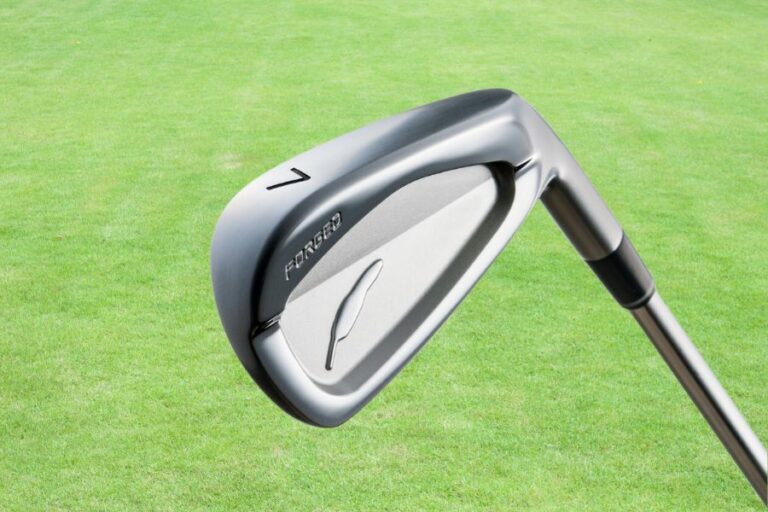What Is The Average Driver Shaft Length And Its Importance?

The average driver shaft length on the PGA tour is approximately 44.75 inches, and its importance lies in the proper optimization of clubhead speed. Here’s all you need to know.
It is critical to be aware of the average driver shaft length as it can affect your course performance.
This article discusses the average driver shaft length, the advantages and disadvantages of using different lengths, and when you should consider changing them.
I. What Is The Average Driver Shaft Length?
The typical retail length of driver shafts stands at 45.5 inches which can be customized to your preferred length.
Here is a gender-wise split up of the average driver length:
Men
The standard driver length for men, when made of steel, is 43.5″ inches and 44″ inches when made of graphite. Despite that, it is a standard practice for most men to carry a driver shaft of 45″ inches.
Women
The average length of a driver shaft for women is 44″ inches. However, this can vary depending on the height and swing speed of the golfer. The lighter weight and shorter length of a driver shaft for women helps them generate more clubhead speed with less effort.
II. How Long Are PGA Tour Professionals’ Drivers?
PGA Tour professionals typically use drivers with shaft lengths ranging from 43 to 46 inches.
Nevertheless, some golfers like Bryson DeChambeau and Phil Mickelson have experimented with longer shafts up to 47.5 inches and 48 inches respectively. Tiger woods on the other hand carries a shorter 42.5 inch driver.
The exact length of a driver can vary depending on a player’s height, swing speed, and personal preference.
iII. What do USGA rules on driver length say?
Originally the USGA had set the driver length limit at a maximum of 48” inches. However, currently, the USGA has established a maximum driver shaft length of 46 inches, which applies to all 14 USGA championships starting in 2022.
According to Thomas Pagel, the senior managing director of USGA, this rule aims to strike a balance between performance and fairness.
Thus, even though some players may prefer longer shaft lengths for increased distance, such as a 72-inch shaft, these are not allowed under the new rules.
The average driver shaft length used on the PGA Tour is around 44.75 inches.
IV. What Does Shaft Length Do For Your Golf Game?
The length of your driver shaft can majorly impact your game at the level of distance and accuracy of your shots. Let us look at these in a little more detail:
1. Distance
The length of a driver shaft can impact the distance that the golf ball travels. In general, a longer shaft will generate more clubhead speed and result in longer drives. On the other hand, a shorter shaft may result in shorter drives.
Golfers who want to maximize distance often opt for shafts that are around 45-46 inches, which provides a good balance between distance and control.
2. Accuracy
A longer shaft means lesser accuracy, as it is tough for the player to maintain control of the golf club.
For golfers who prioritize accuracy, a shorter shaft length may be more suitable. The shorter length allows for better control of the clubface, which can result in more accurate shots.
Shaft lengths around 43-44 inches are often favored by golfers who place a higher emphasis on control and accuracy.
3. Driver Shaft Length Chart based on skill levels
Ideally, amateurs and golfers who can not break a 100 should focus on accuracy rather than distance, as it can disrupt the score, making it even more difficult to achieve a double-digit score.
On the other hand, golfers who achieve below 100 (90 or even 80) can work on their distance as their skills are developed enough to play a great short game and can also manage to get themselves out of the rough when needed.
The mid-low handicappers know that the more shots they have within 150 yards, the more birdies they can hit at closer range.
Moreover, getting the distance allows the golfer to achieve short par 4s in one shot and get even closer to par 5s in a couple of shots.
This makes it easier to break 80 and can help you become a scratcher golfer even sooner.
The table below will help you choose a driver based on skill level.
| Handicap range | Driver length (inches) | Average distance (yards) | Average misdirection |
| 24-36 | 45 44 43 | 206.4 207.0 207.3 | +/- 25.3 +/- 21.3 +/- 16.7 |
| 18-23 | 45 44 43 | 214.2 214.8 215.7 | +/- 26.4 +/- 22.7 +/- 17.0 |
| 12-17 | 45 44 43 | 221.3 222.5 222.8 | +/- 23.5 +/- 18.1 +/- 15.1 |
| 6-11 | 45 44 43 | 227.1 228.1 228.4 | +/- 18.2 +/- 15.6 +/- 11.8 |
| 0-5 | 45 44 43 | 238.7 238.3 237.5 | +/- 15.7 +/- 12.2 +/- 9.7 |
V. Height based chart: Determining The Best Driver Shaft Length
The ideal shaft length for each golfer depends on individual attributes, such as height, age, swing speed, and ball speed.
A driver length that matches up with your height and ‘wrist to floor’ distance is the ideal match for you.
In order to hit the ball with precision and accuracy, short players must generate more speed when swinging a longer-shafted driver.
Doing otherwise would lead to a lack of control over trajectory and direction.
If you choose to extend your driver shaft length with a swing speed of only 100 mph, you likely won’t possess enough ball velocity to control it properly.
Thus, it is important to take into account your swing speed and ball speed when deciding on the best driver shaft length for you.
The chart below compares the driver length, average distance and misdirection. This aims to help you choose the best driver shaft length based on your skill and style of playing the game.
The table below will help you choose a driver based on height.
| Height of the golfer | Wrist To Floor Measurement | Driver Shaft Length |
| 5′ 0″ – 5′ 2″ | 28.50″ to 33.50″ | 41.5″ |
| 5′ 2″ – 5′ 4″ | 30.00″ to 34.00″ | 42.0″ |
| 5′ 4″ – 5′ 6″ | 30.75″ to 35.25″ | 43.0″ |
| 5′ 6″ – 5′ 8″ | 32.00″ to 37.00″ | 43.5″ |
| 5′ 8″ – 5′ 10″ | 34.00″ to 39.00″ | 44.0″ |
| 5′ 10″ – 6′ 0″ | 35.25″ to 40.25″ | 44.5″ |
| 6′ 0″ – 6′ 2″ | 36.50″ to 41.25″ | 45.0″ |
| 6′ 2″ – 5′ 4″ | 38.00″ to 42.00″ | 45.5″ |
| 6′ 4″ – 6′ 6″ | 38.25″ to 43.50″ | 46.0″ |
Experimentation is the key to discovering which driver length and shaft stiffness works best for you. Make sure to try out various lengths of shafts as well as a range of stiffness levels.
VI. How to measure your shaft length yourself?
If you wish to measure the shaft length of the driver, you already have to check if it matches your height and style. Here is how you can do it:
- Place your driver on a flat surface with the grip end touching a wall.
- Using a measuring tape or ruler, measure from the top of the grip to where the shaft meets the clubhead.
- This measurement is your driver shaft length in inches.
VII. The Effects of Shortening a Driver Shaft
Lets understand the effects of shortening a driver shaft:
Stiffness of shaft increases: A common concern is that cutting down the driver shaft can result in it becoming stiffer. If you’re used to a regular flex shaft and decide to shorten it, it may become too stiff. This can lead to issues such as the ball changing direction to the right because there isn’t enough swing speed to keep it on the fairway.
Different feel at address: Shortening a driver shaft can alter its swing weight. For instance, if it goes from D3 to D1 after cutting, it affects how you swing.
Change in swing weight: Another point to note is that the driver may feel shorter when addressing the ball, which could be distracting. However, players can gradually adjust to this new sensation over time.
VIII. Does using a shorter driver shaft make it easier to hit?
For many golfers, shorter drivers are easier to hit. Standing closer to the ball makes it simpler to hit the sweet spot consistently.
In 2017, Rickie Fowler shortened his Cobra driver from 44.5 inches to 43.5 inches. This change led to him hitting 31 out of 42 fairways over three rounds at The Honda Classic, securing a 4-shot victory.
If you’re struggling with consistency, try a shorter shaft for better control. Using a 3 wood shaft can achieve this while maintaining swing balance.
IX. Pros and cons of longer/shorter drivers
Here is a comparison explaining the pros and cons of both long and short driver clubs:
| Feature | Longer Driver | Shorter Driver |
| Pros | Increased clubhead speed Greater reach Increased distance off the tee | Increased accuracy Better control Improved posture Shorter backswing Easier to hit straight shots |
| Cons | Decreased control Harder to hit straight shots Requires a longer swing Can result in a more pronounced slice | Decreased distance off the tee Reduced reach Can be difficult to generate enough clubhead speed |
X. Getting the best performance with your driver shaft length
Here are some tips on getting the best performance out of your driver shaft length:
- Use a swing speed monitor to accurately measure your swing speed, as this will help you make the best decision for the optimal driver shaft length.
- Consider your shot accuracy as well as driving distance when choosing the right driver shaft length for you.
- Don’t overlook the importance of shaft stiffness. Stiffer shafts can increase ball speed and distance, while more flexible shafts can help with accuracy.
- Test out different shaft lengths in a fitting session and compare the results. This will give you an idea of which shaft length provides you with the best performance.
- Lastly, remember that the optimal driver shaft length may vary from player to player, so make sure to find the right match for your style and preferences.
Conclusion
Choosing the right driver shaft length is important in achieving your desired golf performance. Consider the guidelines listed above when selecting the best driver shaft length for you.
FAQ’s
1. Will A Shorter Driver Help My Slice?
It is possible that using a shorter driver may help reduce a slice in your golf game. A shorter club length can increase control and accuracy, allowing for a straighter shot.
2. Can I Put A 3 Wood Shaft In My Driver?
Yes, a 3 wood shaft can be used in a driver and it may enhance your game. It often has a softer flex which could improve control and accuracy. Its shorter length can help reduce slices and promote a compact swing.
Additionally, the weight and balance of the club can be adjusted with a 3 wood shaft, tailoring the feel and performance to your playing style.
3. How Long Is A Driver Shaft Without The Head?
The length of a driver shaft without the head is typically around 44 inches. However, the exact length can vary slightly depending on the manufacturer and the model of the driver.








